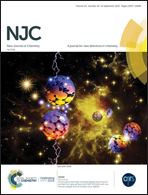Synthesis and coordination properties of new σ2,λ3-P/N switchable chelators based on [1,2,3]-diazaphosphole†
Abstract
Novel hybrid ligands based on [1,2,3]-diazaphosphole (dap) were prepared and their coordination behaviour toward selected transition metals has been studied. The syntheses and spectroscopic properties of polydentate bis(5-t-butyl-[1,2,3]-diazaphosphol-2-yl)-dimethylsilane (BdapsH,tBu) and bis(4-methyl-5-ethyl-[1,2,3]-diazaphosphol-2-yl)-dimethylsilane (BdapsMe,Et) are reported. In zerovalent compounds of the type [M(CO)4(κ2-P,P′-BdapsR1,R2)] (R1 = Me, R2 = Et, M = Cr, Mo and W; R1 = H, R2 = t-Bu, M = W) and [Ni(κ2-P,P′-BdapsH,tBu)2] the ligand serves as a P,P′-donor, giving rigid six-membered chelate rings. BdapsMe,Et is also capable of behaving as an N,N′-chelator as confirmed by isolation of high-spin chelate complex [CoBr2(κ2-N,N′-BdapsMe,Et)]. The reaction of parent 2H-4-methyl-5-ethyl-[1,2,3]-diazaphosphole with NiBr2·DME yielded paramagnetic compound [NiBr2(κ-N-dap)2], where the dap heterocycle bonds with the nickel(II) centre via a 1-nitrogen donor atom in a distorted tetrahedral environment. All the studied complexes showing different coordination modes of the new ligands were fully characterized, including single-crystal X-ray diffraction analysis.
![Graphical abstract: Synthesis and coordination properties of new σ2,λ3-P/N switchable chelators based on [1,2,3]-diazaphosphole](/en/Image/Get?imageInfo.ImageType=GA&imageInfo.ImageIdentifier.ManuscriptID=C9NJ03146D&imageInfo.ImageIdentifier.Year=2019)


 Please wait while we load your content...
Please wait while we load your content...